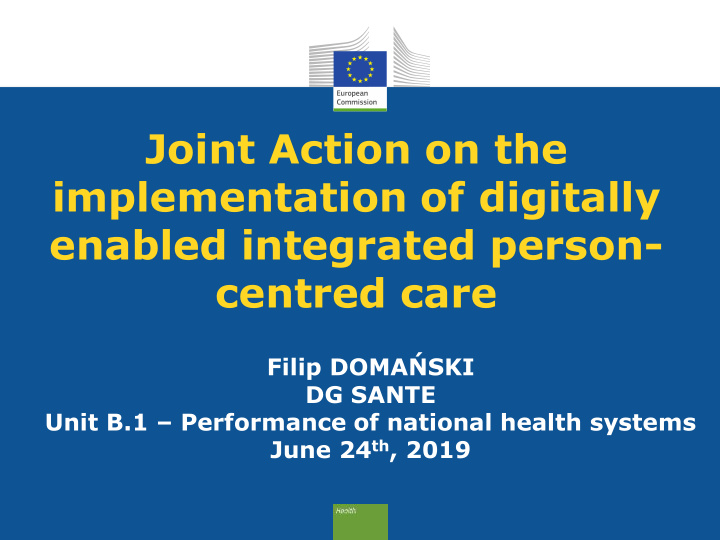



Joint Action on the implementation of digitally enabled integrated person- centred care Filip DOMAŃSKI DG SANTE Unit B.1 – Performance of national health systems June 24 th , 2019
Context The Commission Communication on "enabling the digital transformation of health and care in the Digital Single Market “ Pillar 3 – Digital tools for citizen empowerment and person- centred care Commitment towards: • measures for building the capacity of national and regional authorities to organise and deliver integrated person-centred care • addressing the need for technical assistance for health reforms and digital transformation of health care 2
The aim of the Join Action Reinforcing the capacity of care authorities to address successfully important aspects such as: • change management and re- • building the capacity of organisation of the existing care individuals and communities to models participate in the care process • embedding digital technologies and • citizen empowerment • use of patient reported data tools in care services • re-organisation of patient pathways • new payment methods • health workforce roles and skills • and performance assessment of with digital technologies and data new care models 3
The support offered by the Joint Action • best practice transfer • activities to prepare the local environment for implementation • “ twinning actions ” – dedicated seminars and workshops, study visits, short-term secondment visits, face-to-face meetings, mentoring from experts in the domain, availability of tools and knowledge resources etc. 4
The Joint Action participants Entities that are directly organising and delivering care at national and/or regional or local level - Key for reaching the JA ’ s objectives - Particular attention to this when preparing the JA 5
The Joint Action will build on the work done in • The EU Health Programme • The EU Framework Programmes for Research and Innovation • The European Innovation Partnership on Active and Healthy Ageing 6
The input to the Joint Action • Tools for deploying integrated care (e.g. from EU projects ACT@Scale and SCIROCCO), SANTE's Integrated Care Resource Centre and the work of the EIP AHA • Guidance on how to design, implement and assess integrated care by the EU expert group on Health Systems Performance Assessment • Guidance on the transfer and scaling-up of good practices (the Joint Action CHRODIS) • Guidance for best practice transfer from the twinning projects SCIROCCO Exchange and VIGOUR • Guidance concerning the management of multi-morbidities (the Joint Actions CHRODIS and CHRODIS Plus) • Suggestions regarding health workforce planning and skill-mix (the Joint Action on Health Workforce Planning and Forecasting and the project SEPEN) • Recommendations and tools (the Joint Action eHAction) 7
The Joint Action supported transfer of good practices The Steering Group on Health Promotion and Prevention and Management on Non-Communicable Diseases have chosen: • Basque Health Strategies in ageing and chronicity: integrated care (Spain), • Catalan open innovation hub on ICT-supported integrated care services for chronic patients (Spain), • The OptiMedis Model – Population-Based Integrated Care (as implemented in Gesundes Kinzigtal) (Germany) • Digital roadmap towards an integrated health care sector (Region of Southern Denmark, Denmark) 8
The Joint Action policy expectations • Reinforce the capacity of health authorities to successfully address important aspects of health system transformation, in particular the transition to digitally-enabled, integrated, person-centred care • Support the best practice transfer from the systems of the “ early adopters ” to the ones of the “ next adopters ” “ next adopters ” – the authorities interested in transferring the selected practices “ early adopters ” – owners of the selected practices 9
Joint Action deliverables 10
The Joint Action Structure Deliverables for each of WP5-WP8 • Document the original GP (how it was done step-by-step, how problems were resolved, etc.) • Document the transfer process : how it started, who was involved, who was “ coached ” , how the original practice was adapted, which of its elements were chosen, what other elements were added and from where, how decisions were made, how the final practice to transfer looks like Deliverables of WP9 (or of WP4) • Description of the practices actually piloted • Document the pilots : how they are set up, the locations, the target groups, the number of citizens/patients covered by each pilot, results (quantitative) • WP4: Blueprint how to transfer a good practice 11
The Joint Action Structure Questions to participants • Which Good Practice do you want to transfer? • Do you plan/prefer to mix and match elements from more than one practice? 12
DG SANTE contact filip-michal.domanski@ec.europa.eu 13
Recommend
More recommend